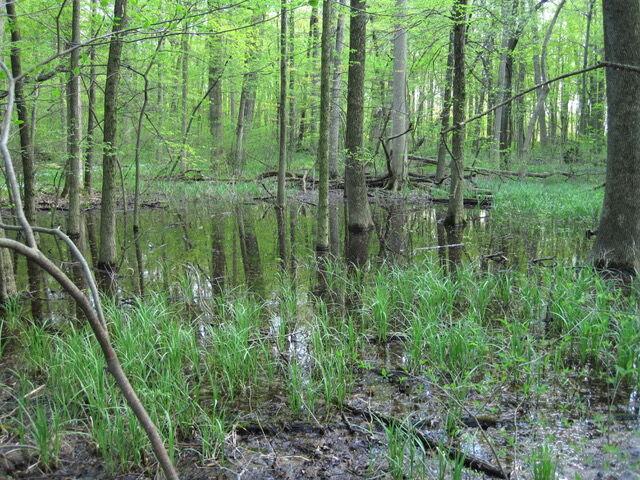One of our most characteristic and productive wetland types in central Indiana is the flatwoods depression. These wetlands occur in flat uplands of the glacial till plain. Although soil classifications may vary by county, this community is often associated with Brookston soils, a silty clay loam soil with low permeability. The soils tend to pond water in the late winter and spring due to their slow infiltration rate that results from the clay content in the upper 3 feet of the soil profile. These flat uplands lend themselves to being cleared for agriculture and drained with tiles drains and ditches that expedite the removal of this surface water. Therefore, most of this wetland type has been lost across central Indiana.
In their natural state, these are forested wetlands with a predictable suite of trees. The wettest areas that pond for significant periods tend to harbor silver maple, red maple, pin oak and swamp white oak. Better-drained areas that pond only briefly harbor Shumard oak, bur oak and shellbark hickory. Green ash was formerly an abundant member of this community before its populations were decimated by the emerald ash borer. Sycamore may occasionally occur, but they are more characteristic of floodplains. Shrubs characteristic of areas of significant ponding include buttonbush (Cephalanthus occidentalis) and winterberry (Ilex verticillata), which is central Indiana’s only native species of holly. Spicebush is the characteristic shrub of areas of shorter duration ponding. A wide variety of sedges (Carex spp), fowl manna grass (Glyceria striata), and wood reed (Cinna arundinacea) are common herbaceous plants of these wet woodlands.
These wetlands may be classified as ephemeral or vernal pools because they typically dry up in early to mid-summer, often resulting in dry cracked soil by early fall. Because of this seasonal drying, they are unable to support fish. This lack of predatory fish allows a whole host of other fauna to complete their life cycle in a relatively short window in the spring and early summer. A wide variety of aquatic insect larvae utilize these pools, including dragonflies, crane flies, mosquitoes and many others.
These wetlands are particularly important for amphibians such as frogs and salamanders. Frogs such as spring peepers and chorus frogs are frequently heard on mild nights in late winter and early spring. A little later in the spring the vocalizations of grey tree frogs and American toads become dominant. A wide variety of salamanders may also occur in these wetlands including red-backed salamanders and Jefferson’s salamanders.
Because these wetlands typically have no apparent surface connections to streams and rivers, they are considered isolated and not protected under the federal Clean Water Act. The bill currently being considered in the state legislature, SB 389 would repeal our state isolated wetland law, jeopardizing all remaining remnants of these important and biologically productive wetlands.
Kevin Tungesvick is a lifelong resident of Madison County. An avid naturalist and self-taught botanist, Kevin is author of a floral inventory of Mounds State Park. He is a founding director of Heart of the River Coalition.
